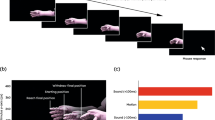Abstract
This brief report represents a post-hoc analysis on the use of fingerspelling as a self-cue by a child with autism who was previously taught to spell with a speech generating device under three feedback conditions: auditory (speech output), visual (Liquid Crystal Display), and auditory-visual (Schlosser et al., Journal of Autism and Developmental Disorders, 28:309–319, 1998). During instruction for this study, the child was provided with fingerspelled input across conditions. In coding the videotaped sessions for correct spelling performance, it was noted that this child seemed to use fingerspelling as self-cues as he was entering a letter into the keyboard. The purpose of this post-hoc analysis was to determine whether he used these fingerspelled self-cues more in certain feedback conditions than others. Results revealed that although the child produced fingerspelled self-cues across conditions, he used them most frequently in the auditory condition and least often in the visual condition. It is hypothesized that this child may have self-generated a visual mnemonic as needed (as a function of the condition) in order to facilitate memory retrieval of letters during spelling.
Similar content being viewed by others
References
Blackburn, D. W., Bonvillian, J. D., & Ashby, R. P. (1984). Manual communication as an alternative mode of language instruction for children with severe reading disabilities. Language, Speech, and Hearing Services in Schools, 15, 22–31.
Graham, S., & Miller, L. (1979). Spelling research and practice: a unified approach. Focus on Exceptional Children, 12, 1–6.
Koehler, L., & Lloyd, L. (1986, September). Using fingerspelling/manual signs to facilitate reading and spelling. Paper presented at the Fourth biennial conference of the International Society for Augmentative and Alternative Communication, Cardiff, Wales, United Kingdom
Koehler, L., Lloyd, L., & Swanson, L. (1994). Visual similarity between manual and printed alphabet letters. Augmentative and Alternative Communication, 10, 87–95.
Layton, L. T. (1988). Language training with autistic children using four different modes of presentation. Journal of Communication Disorders, 21, 333–350.
McKnight, J. C. (1979). Using the manual alphabet in teaching reading to learning disabled children. Journal of Learning Disabilities, 12, 15–18.
Quill, K. A. (1997). Instructional considerations for young children with autism: the rationale for visually cued instruction. Journal of Autism and Developmental Disorders, 27, 697–714.
Schlosser, R. W., Blischak, D. M., Belfiore, P. J., Bartley, C., & Barnett, N. (1998). Effects of synthetic speech output and orthographic feedback on spelling in a student with autism: a preliminary study. Journal of Autism and Developmental Disorders, 28, 309–319.
Author information
Authors and Affiliations
Corresponding author
Additional information
This study was conducted while all authors were at Northeastern University. The affiliations of some authors have changed: Katie Angermeier is now at the Speech and NeuroRehab Center and Center for Pediatric Rehabilitation in Pensacola, Florida. Ulana Harasymowycz is now working at the Comprehensive Kids Developmental School, in the Lower East Side of Manhattan.
Rights and permissions
About this article
Cite this article
Angermeier, K., Schooley, K., Harasymowycz, U. et al. The Role of Fingerspelled Self-Cues during Spelling with a Speech Generating Device by a Child with Autism: A Brief Report. J Dev Phys Disabil 22, 197–200 (2010). https://doi.org/10.1007/s10882-010-9193-1
Published:
Issue Date:
DOI: https://doi.org/10.1007/s10882-010-9193-1




